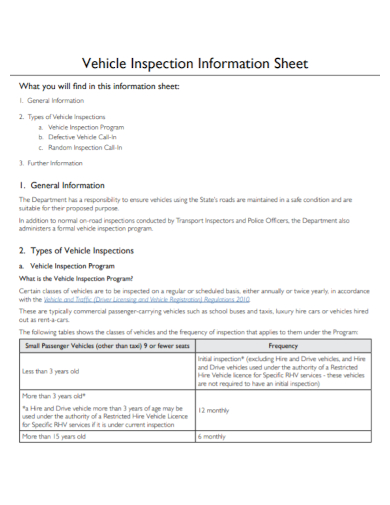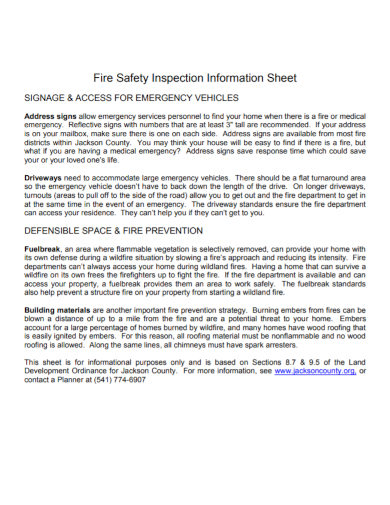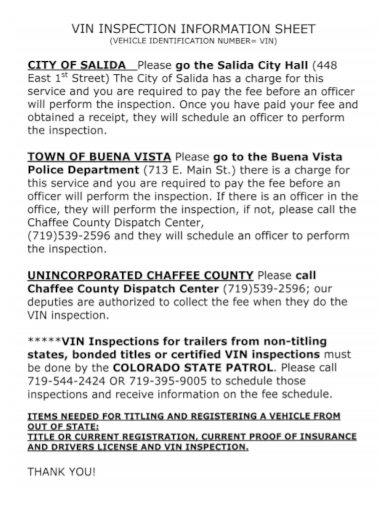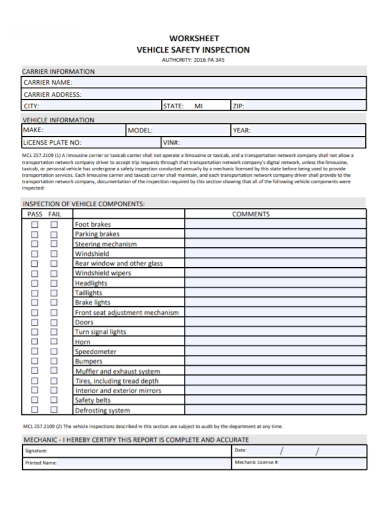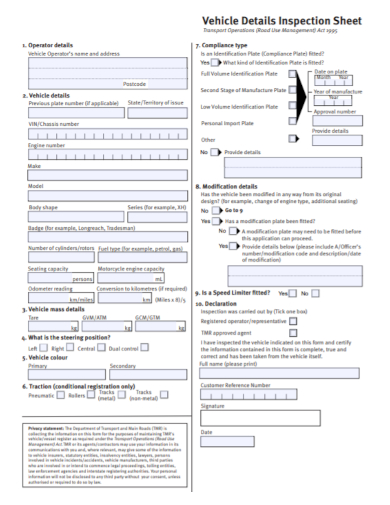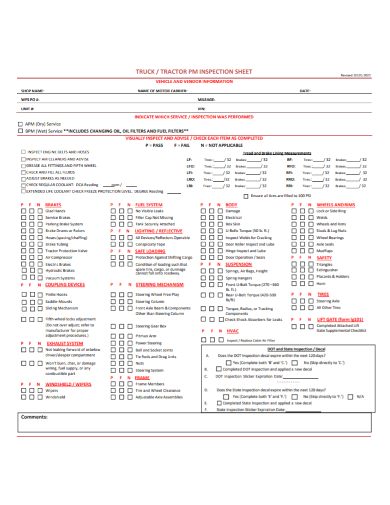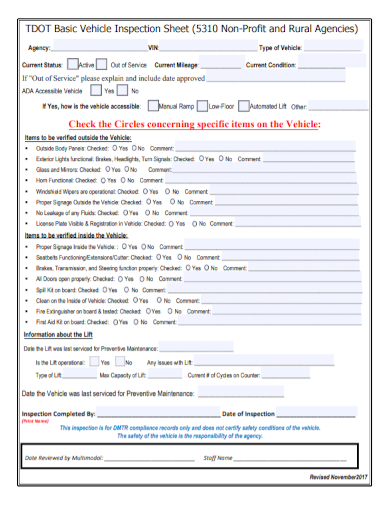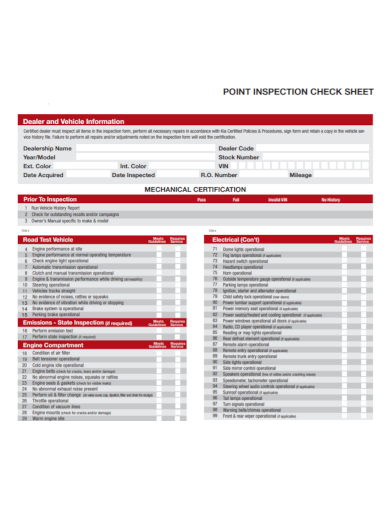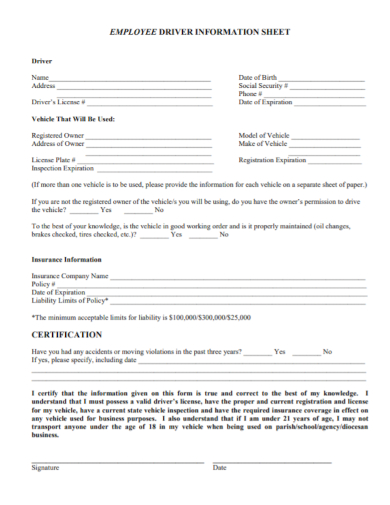Even though there is legislation for car inspections to meet a certain standard, most vehicle owners are complacent once they passed it and do no further checks or proper maintenance of their car for a long time and they don’t realize their car might be losing its proper function thus resulting in road accidents. And that is why vehicle inspections should be done regularly. To aid in inspection, one needs an information sheet to refer to. This article will teach you what items to put on a vehicle inspection sheet and provide you tips on how to inspect a vehicle’s components. This article also has sample templates you can use when you need to make one.
10+ Vehicle Inspection Information Sheet Samples
1. Vehicle Inspection Information Sheet
2. Mobile Food Vehicle Inspection Information Sheet
3. Fire Vehicle Safety Inspection Information Sheet
4. Vehicle Inspection Verification Information Sheet
5. Vehicle Safety Inspection Information Worksheet
6. Vehicle Details Information Inspection Sheet
7. Vehicle Vendor Information Inspection Sheet
8. Agency Vehicle Information Inspection Sheet
9. Dealer Vehicle Information Inspection Check Sheet
10. Employee Vehicle Information Inspection Sheet
11. Vehicle Pre-Use Information Inspection Sheet
Importance of Inspecting Your Vehicle Regularly
Whether you are a vehicle inspector or just a car owner, it’s important to have your vehicle inspected regularly to ensure safety to the driver, the passengers, the vehicle, and other road users. It also presents an opportunity to spot mechanical issues, that put potential hazards or risks to a vehicle.
How to Make a Vehicle Inspection Information Sheet
The list below is the list of components of a car that is usually inspected by inspectors and they are usually found in their information sheet. The sheet is filled out whether your car parts meet the standard regulations or not. The inspection process usually does not take longer than five minutes. You can also do your own inspection weekly or monthly. The following elements are:
- Fluid levels: Check the oil levels, coolant levels, auto transmission fluid levels, and washer fluid levels.
- Engine: Check engine for leaks and damage.
- Belts: Check the belt operations such as seatbelts and timing belts.
- Battery: Check for any signs of corrosion, voltage, and conduct a charge/discharge load test.
- Safety lights: Check those headlights, brake lights, hazard lights, and turn signals are working.
- Windshield wipers: Check the windshield and wiper blades.
- Tire: Check the pressure, tread, and tire wear and tear.
- Brakes: Check the brake fluid, drum wear, brake pads, and rotors.
- Hoses: Check hoses for leaks.
- Mirrors: Check if the mirrors are aligned,
- Cabin Filter: Check your cabin filter for cleanliness and wear.
- Steering and Suspension: Check the power steering belt and power steering pump.
- Exterior: Car exterior inspection.
- Exhaust systems: Check the exhaust manifold, catalytic converter, tailpipes, and muffler for damages, cracks, or leaks.
FAQs
What items should every vehicle carry?
These are the items you should carry in your vehicle to help you in case of emergencies: spare fuse, jacks, warning triangles, spare tire, flashlight, and first aid kit.
What are the three types of vehicle inspection?
There are three types of car inspections – a courtesy inspection; a visual inspection of the common components of a vehicle, an insurance inspection, an inspection required for old cars if it’s still roadworthy enough, and a 12-point inspection; a detailed and thorough inspection of a car.
Should I get a car inspected before buying?
It is definitely a must for cars to be inspected by a qualified professional specialist especially if it’s a used car before you do the final negotiation for purchasing it.
Incorporate vehicle inspection into your daily routine. Never overlook the importance of checking it as it could save your life and the lives of others. Keep a vehicle, whether if it’s yours or not, tidy always to spot any issues. Another pro tip when getting into your car for a trip is to always check around it starting from the passenger side until to the driver side. This will let you see if there any obstructions or damage to the exterior. Never take a vehicle inspection for granted. Checking a vehicle regularly makes a responsible driver that helps save the lives of others. To help you get started on making a vehicle inspection information sheet, download the sample templates above!
Related Posts
FREE 12+ Balance Sheet Formats in MS Word | PDF | Excel
FREE 5+ Construction Bid Sheet Samples in PDF | MS Word | Excel
FREE 15+ Construction Timesheet Samples in PDF | MS Word
FREE 26+ Construction Sheet Samples in MS Word | Google Docs | Excel
FREE 20+ Continuation Sheet Samples in PDF | MS Word
FREE 25+ Program Sheet Samples in MS Word | Google Docs | Pages | PDF
FREE 33+ Student Sheet Samples in PDF | MS Word
FREE 32+ Planning Sheet Samples in PDF | MS Word
FREE 10+ OC Sheet Samples in PDF
FREE 10+ Beat Sheet Samples in PDF
FREE 3+ Paper Sign Up Sheet Samples in PDF
FREE 50+ Summary Sheet Samples in MS Word | Google Docs | Google Sheets | Excel | PDF
FREE 10+ Cleaning Bid Sheet Samples [ Commercial, House, Residential ]
FREE 10+ Group Sheet Samples in PDF
FREE 10+ Family Group Sheet Samples in PDF

